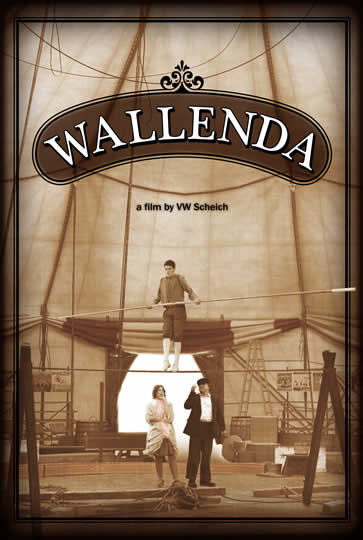 VW Scheich is writer/director of Wallenda, a short period drama about Karl Wallenda’s first high wire performance years before he became the patriarch of The Flying Wallendas, the famous troupe known for its death-defying feats. Wallenda was a unique project in that it was shot entirely against a green screen and contained over 250 CG shots. During post-production VW oversaw a crew of up to 300 CG artists to successfully produce the creation and integration of all the CG elements.
VW Scheich is writer/director of Wallenda, a short period drama about Karl Wallenda’s first high wire performance years before he became the patriarch of The Flying Wallendas, the famous troupe known for its death-defying feats. Wallenda was a unique project in that it was shot entirely against a green screen and contained over 250 CG shots. During post-production VW oversaw a crew of up to 300 CG artists to successfully produce the creation and integration of all the CG elements.
VW’s production company, Rareform Pictures, is currently developing its own slate of original feature film projects, one of which is Pawn, the story of an impossible friendship between a prison guard and an inmate that evolves over a complex game of chess. Pawn was a semi-finalist in the prestigious Nicholl Fellowship in Screenwriting Competition in 2009.
Prior to Wallenda, VW was a Director’s Assistant on Stuart Little II and The Haunted Mansion, both directed by Rob Minkoff, co-director of The Lion King. VW went on to assist Director Angela Robinson for the duration of the film Herbie: Fully Loaded and Director Barry Sonnenfeld during post-production of the film RV. After several years gaining on-set production experience with feature film directors, VW learned the studio side of the movie business by working for Pete Corral, the Senior Vice-President of Production at Columbia Pictures. During his time at Columbia Pictures, VW coordinated sixteen films, including such blockbuster hits as Ghost Rider, Monster House, and Spiderman III.
After leaving Columbia Pictures, VW landed at The Third Floor, a CG pre-visualization studio. As Director of Project and Business Development at The Third Floor, VW utilized his contacts at the major studios to help obtain new projects, such as Iron Man II, Smurfs, Men In Black III, and Jack the Giant Killer. Over the past decade, VW has gained valuable experience in many aspects of the motion picture industry, including script development, financing, production, and post production. Combined with his radio, theatre, and circus backgrounds (he comes from a long line of high wire performers), VW is ready to utilize his skills, knowledge and talent to bring his unique vision of filmmaking to life.
Bijan: How did you come up with the idea of Wallenda and what motivated you to make Wallenda? 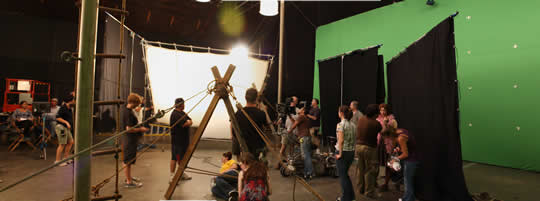
VW Scheich: I was motivated to make this short film because of my family’s background. I come from a long line of circus performers. In addition to my father and mother, who had a motorcycle high wire act during the 1970’s and 1980’s, my paternal grandmother and her extended family were all high wire artists in Europe. One of my cousins even married Karl Wallenda’s grandson. All of my life, I heard about the legend of Karl Wallenda and his daring feats on the high wire. In fact, the day that Karl Wallenda died while performing on the high wire in San Juan, Puerto Rico – March 22, 1978 – was the day that I was born in Ft. Lauderdale, FL. I always wondered how Karl got his start in show business and thought it would be fun to make a short film capturing the beginning of his career.
Bijan: How challenging was it to make this film? How did you go about raising the funds to make this film?
VW Scheich: Although I’ve worked in the film industry for over ten years, making Wallenda was my first endeavor as a filmmaker on a larger scale. I made a couple of other short films but this was my first foray into shooting against a green screen and overseeing the creation and integration of all the CG elements in post-production. The biggest challenge I faced was making a film of this high caliber on a short film budget.
Prior to Wallenda, I was a Director’s Assistant on big budget feature films, such as Stuart Little II, The Haunted Mansion, and Herbie: Fully Loaded. I developed relationships with a lot of talented 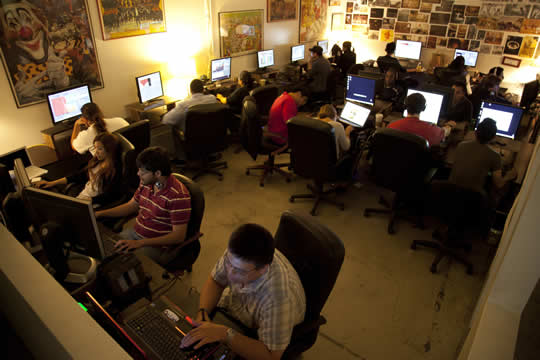 professionals on those films, including John Van Vliet (VFX Supervisor) and Christopher Nibley (Cinematographer), and they were able to help during the shooting of my short, which was instrumental to keep the budget in check. Also, since we shot Wallenda entirely against a green screen during the four-day shoot at New Deal Studios in Marina Del Rey in July 2009, we saved time and money by not having to change locations during the short period of principal photography.
professionals on those films, including John Van Vliet (VFX Supervisor) and Christopher Nibley (Cinematographer), and they were able to help during the shooting of my short, which was instrumental to keep the budget in check. Also, since we shot Wallenda entirely against a green screen during the four-day shoot at New Deal Studios in Marina Del Rey in July 2009, we saved time and money by not having to change locations during the short period of principal photography.
Another challenge we ran into occurred during post-production. During the time that I worked at The Third Floor, a CG pre-visualization studio, I met many VFX artists, including Shawn Hull, Felix Jorge, Christopher Sosebee, Alex Reyes, and Ronnie Cleland, who were all able to help me build CG models and environments for Wallenda. But we realized that we would need a bigger crew of artists to help with the various VFX tasks involved in a film containing over 250 CG shots, tasks such as modeling, rotoing, keying, lighting, texturing, rigging, matte painting, compositing, and digital animation. In conjunction with the Arts Work Foundation, a 501(c)(3) nonprofit entity, we developed an artist-in-residence program centered around Wallenda and provided continuous educational opportunities and hands-on experience for student and junior artists.
We recruited students from the following local art schools – Art Institute Of California-Los Angeles, Art Institute Of California-Inland Empire, Otis School of Design, Art Center of Pasadena, California State University Northridge, Santa Monica College, and Gnomon School of Visual Effects – and matched them with various CG and stereoscopic 3D tasks according to personal preferences and skill levels. With the help of our VFX post producers (Kevin Williams and Gresham Lochner) and other senior artists, we supervised and mentored the junior artists, providing them with crucial feedback and resources in order to hone their skills and find gainful employment as CG artists in the entertainment industry.
So, all in all it was a huge effort from everyone involved to help make the film come together, including our amazing Emmy Award winning composer, Boris Zelkin. I’ve worked with him for a long time and his score connected the film beautifully.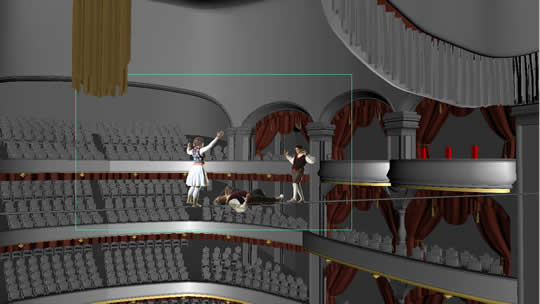
Bijan: As far as using students from the Art Institute of Los Angeles; how did you become familiar with the school and how was the work of the students?
VW Scheich: I initially heard about the Art Institute of Los Angeles from Michael Bertsch, a student at AI who was also an intern at The Third Floor at the same time I worked there. Michael thought Wallenda sounded interesting and he wanted to work on some of the shots for his production class.
So Michael Bertsch introduced me to Michael Libonati, the Academic Department Director of Media Arts & Animation/Visual Effects & Motion Graphics at the Art Institute of California – Los Angeles. Through several meetings, Michael Libonati and I structured a class for AI students centered around Wallenda, which is how the artist-in-residence program with the Arts Work Foundation started.
You have to give a lot of credit to AI for creating an environment that fosters a hands-on learning experience for its students, especially in a field like the film industry where such experience is crucial. The students were enthusiastic and eager to learn and I was really comfortable working with them on my project. When the students had finished their part on Wallenda, we helped them with their resumes and reels, and also with the interview process so that they would hopefully have an edge in finding jobs as VFX artists.
Because many of the students had the opportunity to work in a professional studio environment on Wallenda, they were able to find work at major VFX houses afterwards, 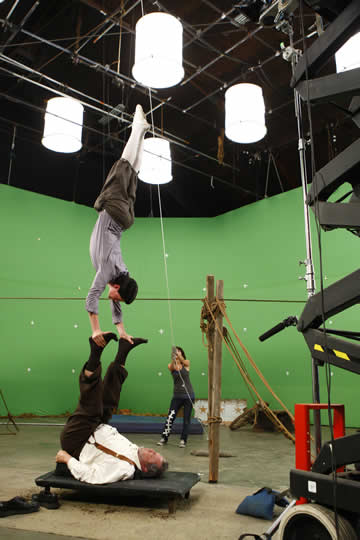 such as Sony Pictures Imageworks, Sassoon Film Design, Stereo D, 9K9, and West Wing Studios.
such as Sony Pictures Imageworks, Sassoon Film Design, Stereo D, 9K9, and West Wing Studios.
Bijan: How did you go about casting the film?
VW Scheich: I worked with Toby Guidry, our casting director, to cast the film.
Toby and I first met while working on Disney’s Herbie: Fully Loaded together.
Initially, we thought about casting American actors who would speak in German accents. But the more we talked about the project, we decided that we wanted it to be really authentic so we ended up looking for German-speaking actors for all the roles.
We had a 3-day casting call and met many wonderful actors. The ones we ended up casting in the roles, however, just brought the characters to life so perfectly and the best part was that two of them were native German speakers. The actors that needed a little more practice worked with Nina Reyes, our German language consultant, in the weeks leading up to shooting.
Bijan: Any future projects lined up?
VW Scheich: Yes, I’m always working! I’m currently developing a slate of ten original projects with my wife, Uyen Le, who co-founded our development and production company RareForm Pictures. Wallenda, the short film, is a proof of concept for a feature film or a miniseries project, which we’re moving forward with in conjunction with another producer. We’re also seeking funding for an original feature screenplay we wrote entitled Pawn. Check out all out projects in development on our company website

